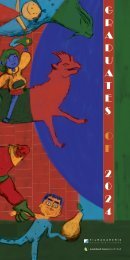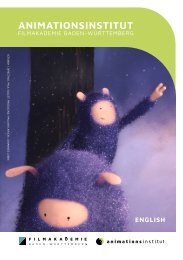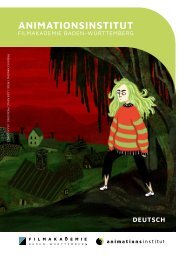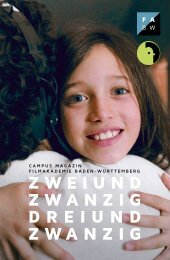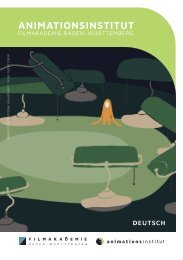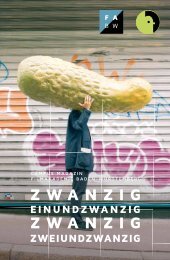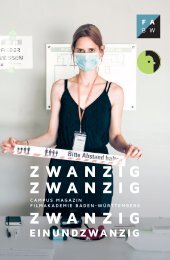Filmakademie Baden-Württemberg Campus Magazin 23/24
Sie wollen auch ein ePaper? Erhöhen Sie die Reichweite Ihrer Titel.
YUMPU macht aus Druck-PDFs automatisch weboptimierte ePaper, die Google liebt.
think it wasn’t Shetland. The lighthouse was one such<br />
find. Suddenly I was convinced that Wagner must live<br />
in it. In the story, Wagner was basically punitively transferred<br />
and sent to a remote part of the world to do field<br />
research. I thought the lighthouse was an perfect symbol<br />
for someone who is practically trapped in such a lonely<br />
place. Luckily, the idea also resonated with Frank Doelger,<br />
so we pursued it.<br />
What exactly does the collaboration between<br />
classic production design and the VFX supervisor<br />
look like?<br />
did, we at least discussed the possibilities. I was able to<br />
learn a lot in the process. When I graduated from the <strong>Filmakademie</strong>,<br />
I felt sufficiently well trained and was able<br />
to contribute my experience. That is an important factor<br />
in being able to discuss with other trades.<br />
You also said in the interview mentioned above<br />
that although the director has the final say, you<br />
fight for your own vision until then. Has it ever<br />
happened that you didn’t recognize this vision<br />
in the finished film and you were totally disappointed?<br />
I try to connect with the VFX department very early on.<br />
The VFX supervisor Jan Stoltz was one of the first people<br />
I worked with on THE SWARM. For me, that’s very important<br />
when I’m designing a world. Because first of all<br />
it doesn’t matter whether I create it through buildings or<br />
through a location that I adapt or whether it is realized<br />
on the computer. These are simply different possibilities<br />
that I have at hand. And of course, I have my preferred<br />
variant. I prefer to realize everything in front of the camera<br />
and only try to use VFX where it is really necessary.<br />
But such worlds very often need set extensions, mostly<br />
as compositing or matte painting, to complete them. Not<br />
to mention a creature like the Yrr, which we developed<br />
organically but then implemented with VFX. It was important<br />
for me to discuss with Jan early on whether it<br />
would all work for him. I always looked at the locations<br />
with a view to what might have to be added or changed<br />
in digital post-production and then coordinated my ideas<br />
with Jan in a timely manner. How far can we intervene<br />
in the landscape? Can we use the trees all the way<br />
to the beach? Is the addition still 2D, “2.5D” or do we<br />
already need a 3D element? Can we add water or will<br />
that be too expensive? We were always in a very good<br />
exchange and also worked closely together in post-production.<br />
Did you benefit from the fact that there is an interdisciplinary<br />
workshop on digital set extensions<br />
at FABW?<br />
I had very good access to it early on. On the one hand,<br />
because I originally come from photography and I was<br />
already involved with the possibilities of compositing at<br />
that time. On the other hand, because at FABW, Animation<br />
with an own institute is a separate and important<br />
discipline. Regardless of the special workshops, animation<br />
is always a topic here. And in most of the projects I<br />
In the end, everyone brings in their own ideas, and at a<br />
certain point you find a common vision. But I have definitely<br />
experienced some disappointments. Film is an artistic<br />
process that involves many people. That’s the beauty<br />
of the craft, but it often leads to a result that doesn’t<br />
quite match one’s own vision. How far this deviates, you<br />
usually only see after the editing. You have to let go at<br />
a certain moment. In production design, this process already<br />
begins during the shoot. Sometimes a project then<br />
develops in a different direction due to various factors.<br />
Especially when working with the actors, a whole new<br />
component comes into play. There are always situations<br />
in which you think to yourself: we had discussed this<br />
differently or had already illustrated it with concept<br />
drawings and storyboards. What happened to the common<br />
idea? I actually fight for a long time for the vision<br />
I have in my head. I also see that as my task: to bring in<br />
a design attitude and to make sure that it is consistently<br />
carried out. That a stringent look is created that is not<br />
constantly broken up. The DoP also makes sure that the<br />
visual language and the lighting concept are carried out<br />
consistently. Sometimes elements that were very important<br />
to you get cut out in the editing process. That’s the<br />
little pain you feel now and then, it happens to all the<br />
trades. But I have never experienced that this common<br />
vision has completely turned around - or I have suppressed<br />
such memories.<br />
In the course of THE SWARM, have you become<br />
increasingly involved with topics such as environmental<br />
protection, climate change or sustainability?<br />
These topics have been with me for a very long time and<br />
are always in focus, not only in my professional life. At<br />
THE SWARM, the topic of green production was a binding<br />
requirement for the first time. This is not always<br />
75




